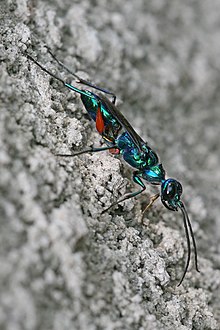Emerald cockroach wasp
| Emerald cockroach wasp | |
|---|---|
 |
|
| Ampulex compressa | |
| Scientific classification | |
| Kingdom: | Animalia |
| Clade: | Euarthropoda |
| Class: | Insecta |
| Order: | Hymenoptera |
| Family: | Ampulicidae |
| Genus: | Ampulex |
| Species: | A. compressa |
| Binomial name | |
|
Ampulex compressa (Fabricius, 1781) |
|
| Synonyms | |
|
|
The emerald cockroach wasp or jewel wasp (Ampulex compressa) is a solitary wasp of the family Ampulicidae. It is known for its unusual reproductive behavior, which involves stinging a cockroach and using it as a host for its larvae. It thus belongs to the entomophagous parasites.
The wasp is mostly found in the tropical regions of South Asia, Africa and the Pacific islands. The flying wasps are more abundant in the warm seasons of the year.
A. compressa was introduced to Hawaii by F.X. Williams in 1941 as a method of biocontrol. This has been unsuccessful because of the territorial tendencies of the wasp, and the small scale on which they hunt.
The wasp has a metallic blue-green body, with the thighs of the second and third pair of legs red. The female is about 22 mm long; the male is smaller and lacks a stinger.
As early as the 1940s it was reported that female wasps of this species sting a cockroach (specifically a Periplaneta americana, Periplaneta australasiae or Nauphoeta rhombifolia) twice, delivering venom. A 2003 study using radioactive labeling demonstrated that the wasp stings precisely into specific ganglia of the roach. It delivers an initial sting to a thoracic ganglion and injects venom to mildly and reversibly paralyze the front legs of its victim. The biochemical basis of this transient paralysis is discussed in a 2006 paper. Temporary loss of mobility in the roach facilitates the second venomous sting at a precise spot in the victims's head ganglia (brain), in the section that controls the escape reflex. As a result of this sting, the roach will first groom extensively, and then become sluggish and fail to show normal escape responses. In 2007 it was reported that the venom of the wasp blocks receptors for the neurotransmitter octopamine.
...
Wikipedia
